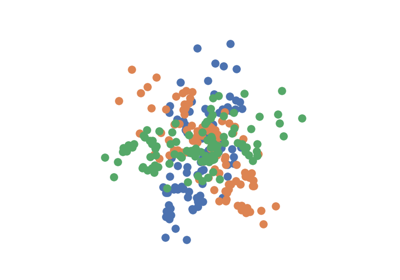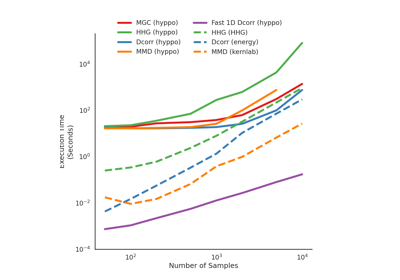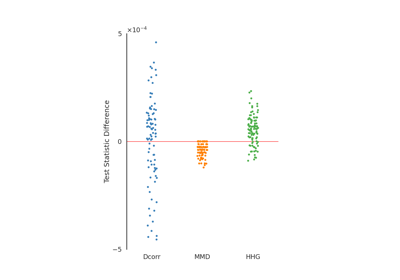MMD¶
-
class
hyppo.ksample.MMD(compute_kernel='gaussian', bias=False, **kwargs)¶ Maximum Mean Discrepency (MMD) test statistic and p-value.
MMD is a powerful multivariate 2-sample test. It leverages kernel similarity matrices capabilities (similar to tests like distance correlation or Dcorr). In fact, MMD statistic is equivalent to our 2-sample formulation nonparametric MANOVA via independence testing, i.e.
hyppo.ksample.KSample, and tohyppo.independence.Dcorr,hyppo.ksample.DISCO,hyppo.independence.Hsic, andhyppo.ksample.Energy1 2.- Parameters
compute_kernel (
str,callable, orNone, default:"gaussian") -- A function that computes the kernel similarity among the samples within each data matrix. Valid strings forcompute_kernelare, as defined insklearn.metrics.pairwise.pairwise_kernels,[
"additive_chi2","chi2","linear","poly","polynomial","rbf","laplacian","sigmoid","cosine"]Note
"rbf"and"gaussian"are the same metric. Set toNoneor"precomputed"ifxandyare already similarity matrices. To call a custom function, either create the similarity matrix before-hand or create a function of the formmetric(x, **kwargs)wherexis the data matrix for which pairwise kernel similarity matrices are calculated and kwargs are extra arguements to send to your custom function.bias (
bool, default:False) -- Whether or not to use the biased or unbiased test statistics.**kwargs -- Arbitrary keyword arguments for
compute_kernel.
Notes
Traditionally, the formulation for the 2-sample MMD statistic is as follows 3:
Define \(\{ u_i \stackrel{iid}{\sim} F_U,\ i = 1, ..., n \}\) and \(\{ v_j \stackrel{iid}{\sim} F_V,\ j = 1, ..., m \}\) as two groups of samples deriving from different distributions with the same dimensionality. If \(k(\cdot, \cdot)\) is a kernel metric (i.e. Gaussian) then,
\[\mathrm{MMD}_{n, m}(\mathbf{u}, \mathbf{v}) = \frac{1}{m(m - 1)} \sum_{i = 1}^m \sum_{j \neq i}^m k(u_i, u_j) + \frac{1}{n(n - 1)} \sum_{i = 1}^n \sum_{j \neq i}^n k(v_i, v_j) - \frac{2}{mn} \sum_{i = 1}^n \sum_{j \neq i}^n k(v_i, v_j)\]The implementation in the
hyppo.ksample.KSampleclass (usinghyppo.independence.Hsicusing 2 samples) is in fact equivalent to this implementation (for p-values) and statistics are equivalent up to a scaling factor 2.The p-value returned is calculated using a permutation test uses
hyppo.tools.perm_test. The fast version of the test useshyppo.tools.chi2_approx.References
- 1
Sambit Panda, Cencheng Shen, Ronan Perry, Jelle Zorn, Antoine Lutz, Carey E. Priebe, and Joshua T. Vogelstein. Nonpar MANOVA via Independence Testing. arXiv:1910.08883 [cs, stat], April 2021. arXiv:1910.08883.
- 2(1,2)
Cencheng Shen and Joshua T. Vogelstein. The exact equivalence of distance and kernel methods in hypothesis testing. AStA Advances in Statistical Analysis, September 2020. doi:10.1007/s10182-020-00378-1.
- 3
Arthur Gretton, Karsten M. Borgwardt, Malte J. Rasch, Bernhard Schölkopf, and Alexander Smola. A Kernel Two-Sample Test. Journal of Machine Learning Research, 13(25):723–773, 2012.
Methods Summary
|
Calulates the MMD test statistic. |
|
Calculates the MMD test statistic and p-value. |
-
MMD.statistic(x, y)¶ Calulates the MMD test statistic.
-
MMD.test(x, y, reps=1000, workers=1, auto=True, random_state=None)¶ Calculates the MMD test statistic and p-value.
- Parameters
x,y (
ndarray) -- Input data matrices.xandymust have the same number of dimensions. That is, the shapes must be(n, p)and(m, p)where n is the number of samples and p and q are the number of dimensions.reps (
int, default:1000) -- The number of replications used to estimate the null distribution when using the permutation test used to calculate the p-value.workers (
int, default:1) -- The number of cores to parallelize the p-value computation over. Supply-1to use all cores available to the Process.auto (
bool, default:True) -- Automatically uses fast approximation when n and size of array is greater than 20. IfTrue, and sample size is greater than 20, thenhyppo.tools.chi2_approxwill be run. Parametersrepsandworkersare irrelevant in this case. Otherwise,hyppo.tools.perm_testwill be run.
- Returns
Examples
>>> import numpy as np >>> from hyppo.ksample import MMD >>> x = np.arange(7) >>> y = x >>> stat, pvalue = MMD().test(x, y) >>> '%.3f, %.1f' % (stat, pvalue) '-0.015, 1.0'


